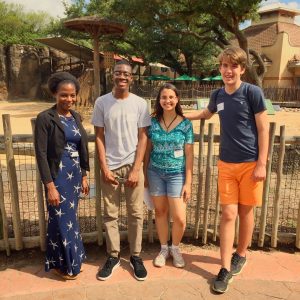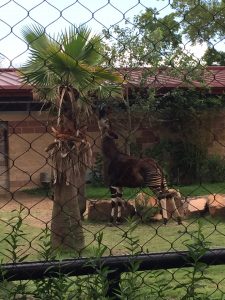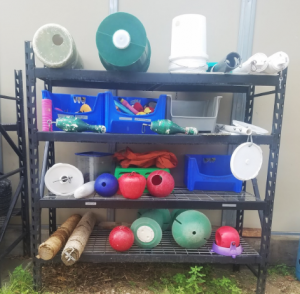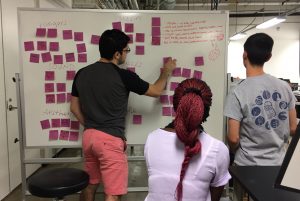What does a zoo, a game of telephone, three pieces of construction paper and a textbook have in common? This might seem like an extremely eclectic selection of nouns, but they all comprised part of my first week at the Summer Experience in Engineering Design (or SEED) hosted at Rice’s Oshman Engineering Design Kitchen (OEDK).
My name is Tori, and I’m a rising sophomore here at Rice University. I’m studying mechanical engineering with a minor in engineering design, so this chance to work with students from other countries on engineering design-specific challenges is a great opportunity to learn more and hone my skills in this field.
We started the week with an orientation to the program and the OEDK proper. As a student at Rice who has previously worked on engineering design projects, I was already fairly familiar with the facilities we would be working with, but it’s always nice to get a review on the important things, like how to use the printers and the fact that there are actually two (2!) bathrooms in the OEDK. Because we are working with students from Malawi and Brazil, it’s super important for them to feel comfortable in this space and this country because they will be working and living in it for the next seven weeks. It was cool to experience the seminars designed for the international students and see American culture from a new perspective. For instance, the Malawians have a radically different concept of internet usage than we do in America, so it was fascinating to learn about those cultural differences.
We also went on a scavenger hunt in the zoo to introduce us to our first design project (more on that in a moment). Even though we sort of abandoned the scavenger hunt halfway through due to some outdated clues, we still had a great time looking at all the animals and hunting down old projects from the OEDK. I haven’t been to a zoo in years so it was super cool to see all of the animals, from elephants and giraffes to kimodo dragons and mantella frogs. We were less successful on the OEDK project hunt because several of the projects were not on display or in use, but we did see the giraffe feeder built a couple of years ago (pictured below).

Tiwonge, Kelvin, me, and Jake with the giraffes at the zoo. If you look closely above Kelvin’s head, you can see the giraffe feeder that was created through a previous OEDK project.
It turns out that the zoo field trip was actually a lead-in to our first engineering design project. Because the participants in SEED come from three different countries (USA, Brazil, and Malawi), it is vital that we are all on the same page when discussing and working through the engineering design process on our projects this summer. The most efficient way to do this is go through engineering boot camp, which is essentially the entire semester of the Introduction to Engineering Design class shoved into five days. So we are going through the entire process – from receiving a problem that must be solved and determining a solution for it to building and testing and hopefully delivering it – in the span of a week.
Our task is to build an enrichment device for the okapi at the Houston Zoo. An enrichment device helps the animals use skills or do activities that they would do in the wild, such as foraging for food in a PVC pipe or scratching themselves with a pole covered in rope. I had never even heard of an okapi before Wednesday morning, so I was way out of my league on this project, but by the end of the day, I felt like I knew a fair amount about this endangered animal. They are the only living relative of the giraffe, and they only live in the Ituri rain forest in the Democratic Republic of Congo. They have prehensile tongues that are 18(!) inches long and can be used as a flyswatter or for grooming or, you know, eating.
We talked to our client sponsor, Kim, about the current enrichment devices for the okapi. She told us about their behavior, their preferences, and the current enrichment devices that the zoo has for the animals. She then led us around behind the scenes to the back of the exhibit where we could actually see and research their current solutions for the problem of enriching the okapi. I conducted the interview with Kim, and through that, we learned a lot of valuable information about what the zoo was looking for from us and how to go about building it.
This gave us the information we needed to get started. We returned to the OEDK and immediately began researching more about the problem. We looked up more information about the okapi, information about other enrichment devices for similar animals, information about the density of hay, and everything else we could possibly need to know for designing the best okapi enrichment device that we can. Once we finished researching, it was time to determine what important design criteria we will need to meet. For instance, we want our device to be entertaining for the okapi and easy to set up/clean for the zookeepers so they will actually utilize our device. We split into smaller teams and began brainstorming ideas for the problem, and we came up with over 50 ideas ranging from filling windchimes with food for the okapi to play with to building a piston-powered maze for the okapi to retrieve food from to an okapi-powered fidget spinner with sound. More on that one if it ever develops.
Now that we have finished brainstorming, we have to sort through our ideas and determine which solution is actually the best one to pursue for the zoo. That is today’s task, and then next week we will begin building and testing our prototype. I am confident that we can deliver an excellent solution to the Houston Zoo next week.



